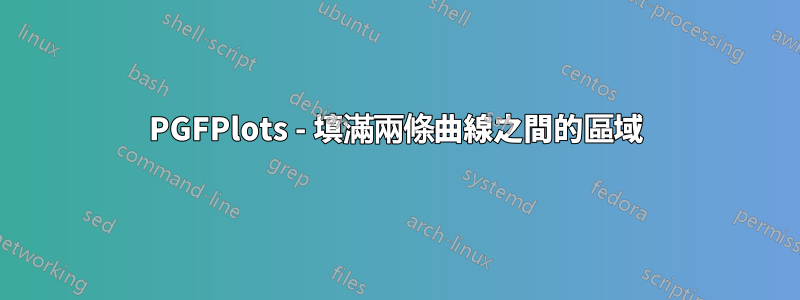
三天前,我在 Stack Exchange 上發布了一個關於如何填充兩條曲線之間的區域的問題(看問題)。我的目標是填充區域兩條曲線顏色不同基於一個何時高於另一個。關鍵是結果持續的。這表示當圖 1(目標)高於圖 2(基準)時,下方的面積應始終為綠色的。但當地塊 2 高於地塊 1 時,下面的面積應始終為紅色的。針對我的問題,我從 esdd 和 Ross 那裡收到了兩個很好的解決方案。然而,當曲線和曲線背景變得更加複雜時,這兩種方法都不夠。
您將在下面找到按相應順序排列的內容:
- 我正在處理的情節的屏幕截圖
- 微量元素
- 解釋為什麼兩種解決方案都很好,但對於該圖來說不是最佳的。
這些解決方案包含在 MWE 中(並進行了評論)。
微量元素:
\documentclass{article}
\usepackage{pgfplots}
\usepgfplotslibrary{fillbetween}
\pgfplotsset{compat=newest}
\pgfplotstableread[col sep=semicolon,trim cells]{
index;value;bins;benchmark_hoeveelheid;benchmark_cumulatief;target_hoeveelheid;target_cumulatief;
1;30;1-30;1;1;0;0;
2;60;31-60;1;3;0;0;
3;90;61-90;2;5;0;0;
4;120;91-120;4;9;7;7;
5;150;121-150;4;13;29;36;
6;180;151-180;6;19;0;36;
7;210;181-210;4;23;7;43;
8;240;211-240;6;29;0;43;
9;270;241-270;4;32;0;43;
10;300;271-300;5;37;0;43;
11;330;301-330;3;40;0;43;
12;360;331-360;5;45;7;50;
13;390;361-390;4;49;14;64;
14;420;391-420;4;53;0;64;
15;450;421-450;5;57;7;71;
16;480;451-480;4;61;0;71;
17;510;481-510;3;65;7;79;
18;540;511-540;3;68;0;79;
19;570;541-570;3;70;0;79;
20;600;571-600;2;73;0;79;
21;630;601-630;3;76;0;79;
22;660;631-660;3;79;0;79;
23;690;661-690;2;81;0;79;
24;720;691-720;2;84;0;79;
25;750;721-750;2;86;0;79;
26;780;751-780;2;88;0;79;
27;810;781-810;0;88;0;79;
28;840;811-840;1;89;0;79;
29;870;841-870;0;90;0;79;
30;900;871-900;0;90;7;86;
31;930;901-930;1;91;7;93;
32;960;931-960;0;91;0;93;
33;990;961-990;0;92;0;93;
34;1020;991-1020;1;93;0;93;
35;1050;1021-1050;1;93;0;93;
36;1080;1051-1080;0;94;0;93;
37;1110;1081-1110;0;94;7;100;
38;1140;1111-1140;0;95;0;100;
}\data
\begin{document}
\begin{figure}[h]
\begin{tikzpicture}[trim axis left]
\begin{axis}[
x tick label style={
/pgf/number format/1000 sep=},
scale only axis,
height=10cm,
width=\textwidth,
ymin=0,
every node near coord/.append style={font=\tiny, inner sep=1pt},
xtick=data,
xticklabels from table={\data}{value},
%xticklabel={\euro\pgfmathprintnumber\tick},
xticklabel style={rotate=45},
xticklabel style={font=\tiny},
yticklabel={\pgfmathparse{\tick*1}\pgfmathprintnumber{\pgfmathresult}\%},
yticklabel style={font=\scriptsize},
ymajorgrids,
xmajorgrids,
bar width=0.1cm,
enlarge x limits=0.01,
enlarge y limits={value=0.05,upper},
legend style={at={(0.5,-0.07)},
anchor=north,legend columns=-1},
]
\addplot[name path=plot1,draw=green!60!black,thick,sharp plot]
table [x=index, y=target_cumulatief] {\data};
\addplot[name path=plot2,draw=blue!70!pink,thick,sharp plot]
table [x=index, y=benchmark_cumulatief] {\data};
% SOLUTION 1
%
% \path[name path=xaxis](current axis.south west)--(current axis.south east);
% \addplot[fill opacity=0.2, green] fill between[
% of = plot1 and plot2,
% split
% ];
% \addplot[fill opacity=1, white] fill between[of = plot1 and xaxis];
% SOLUTION 2
% \addplot
% fill between[of = plot1 and plot2,
% split,
% every segment no 0/.style={fill=green, fill opacity=0.2},
% every segment no 1/.style={fill=red, fill opacity=0.2},
% every segment no 2/.style={fill=green, fill opacity=0.2},
% every segment no 3/.style={fill=red, fill opacity=0.2},
% every segment no 4/.style={fill=green, fill opacity=0.2},
% every segment no 5/.style={fill=red, fill opacity=0.2},
% every segment no 6/.style={fill=green, fill opacity=0.2},
% every segment no 7/.style={fill=red, fill opacity=0.2},
% ];
\legend{{Target},{Benchmark}}
\end{axis}
\end{tikzpicture}
\end{figure}
\end{document}
解決方案一:
第一個解決方案使用 x 軸和兩條曲線之間的差異來為下面的區域著色。這意味著,雖然當圖 1 高於圖 2 時可以對曲線下方的區域進行著色,但反之則不起作用。此外,網格被白色遮擋。
解決方案2:
這個解決方案越來越接近我想要的,但缺乏一致性。您必須指定您希望不同段具有什麼顏色,這表示它不會自動偵聽我的預定義規則「plot 1>plot2 = green」和「plot2>plot1 = red」。
我知道我可能聽起來很挑剔,但這對我來說非常重要,要百分之百正確。如果我要繪製大量此類圖表,這些範例還不夠,因為我必須手動調整所有這些圖表。
希望有人可以根據這些詳細資訊幫助我。另外,我還想提一下這個問題+解決方案,因為我認為findintersections此處創建的命令可能是獲勝的解決方案。但是,在這種情況下它不起作用,因為您需要一個常數和一條曲線,而我正在使用兩條曲線。儘管如此,如果可以進行調整,它就會起作用。
答案1
您可以填滿圖層中的區域axis background。然後他們的填充物就在網格後面。
也許可以使用稍微不同的顏色來填滿。然後,您可以用一種顏色填滿曲線之間的區域,然後將其中一條曲線和 x 軸之間的區域填入白色。在最後一步中,您可以使用不透明度使用第二種顏色為曲線之間的區域著色。
代碼:
\documentclass{article}
\usepackage{pgfplots}
\usepgfplotslibrary{fillbetween}
\pgfplotsset{compat=newest}
\pgfplotstableread[col sep=semicolon,trim cells]{
index;value;bins;benchmark_hoeveelheid;benchmark_cumulatief;target_hoeveelheid;target_cumulatief;
1;30;1-30;1;1;0;0;
2;60;31-60;1;3;0;0;
3;90;61-90;2;5;0;0;
4;120;91-120;4;9;7;7;
5;150;121-150;4;13;29;36;
6;180;151-180;6;19;0;36;
7;210;181-210;4;23;7;43;
8;240;211-240;6;29;0;43;
9;270;241-270;4;32;0;43;
10;300;271-300;5;37;0;43;
11;330;301-330;3;40;0;43;
12;360;331-360;5;45;7;50;
13;390;361-390;4;49;14;64;
14;420;391-420;4;53;0;64;
15;450;421-450;5;57;7;71;
16;480;451-480;4;61;0;71;
17;510;481-510;3;65;7;79;
18;540;511-540;3;68;0;79;
19;570;541-570;3;70;0;79;
20;600;571-600;2;73;0;79;
21;630;601-630;3;76;0;79;
22;660;631-660;3;79;0;79;
23;690;661-690;2;81;0;79;
24;720;691-720;2;84;0;79;
25;750;721-750;2;86;0;79;
26;780;751-780;2;88;0;79;
27;810;781-810;0;88;0;79;
28;840;811-840;1;89;0;79;
29;870;841-870;0;90;0;79;
30;900;871-900;0;90;7;86;
31;930;901-930;1;91;7;93;
32;960;931-960;0;91;0;93;
33;990;961-990;0;92;0;93;
34;1020;991-1020;1;93;0;93;
35;1050;1021-1050;1;93;0;93;
36;1080;1051-1080;0;94;0;93;
37;1110;1081-1110;0;94;7;100;
38;1140;1111-1140;0;95;0;100;
}\data
\begin{document}
\begin{figure}[h]
\begin{tikzpicture}[trim axis left,
fill between/on layer=axis background% <- filling behind the grid
]
\begin{axis}[
x tick label style={
/pgf/number format/1000 sep=},
scale only axis,
height=10cm,
width=\textwidth,
ymin=0,
every node near coord/.append style={font=\tiny, inner sep=1pt},
xtick=data,
xticklabels from table={\data}{value},
%xticklabel={\euro\pgfmathprintnumber\tick},
xticklabel style={rotate=45},
xticklabel style={font=\tiny},
yticklabel={\pgfmathparse{\tick*1}\pgfmathprintnumber{\pgfmathresult}\%},
yticklabel style={font=\scriptsize},
ymajorgrids,
xmajorgrids,
bar width=0.1cm,
enlarge x limits=0.01,
enlarge y limits={value=0.05,upper},
legend style={at={(0.5,-0.07)},
anchor=north,legend columns=-1},
]
\addplot[name path=plot1,draw=green!60!black,thick,sharp plot]
table [x=index, y=target_cumulatief] {\data};
\addplot[name path=plot2,draw=blue!70!pink,thick,sharp plot]
table [x=index, y=benchmark_cumulatief] {\data};
\path[name path=xaxis](current axis.south west)--(current axis.south east);
\addplot[green!30] fill between[
of = plot1 and plot2,
split
];
\addplot[white] fill between[of = plot1 and xaxis];
\addplot[red!70!yellow,fill opacity=.2] fill between[
of = plot1 and plot2,
split
];
\legend{{Target},{Benchmark}}
\end{axis}
\end{tikzpicture}
\end{figure}
\end{document}






